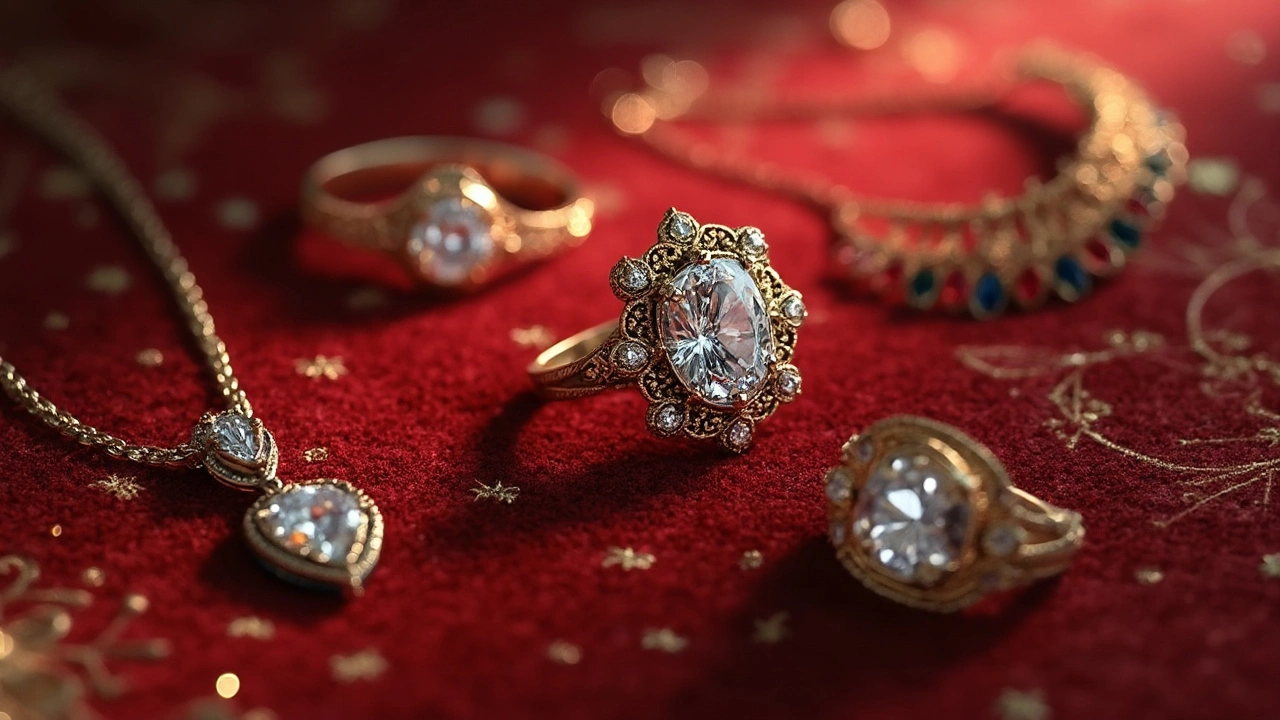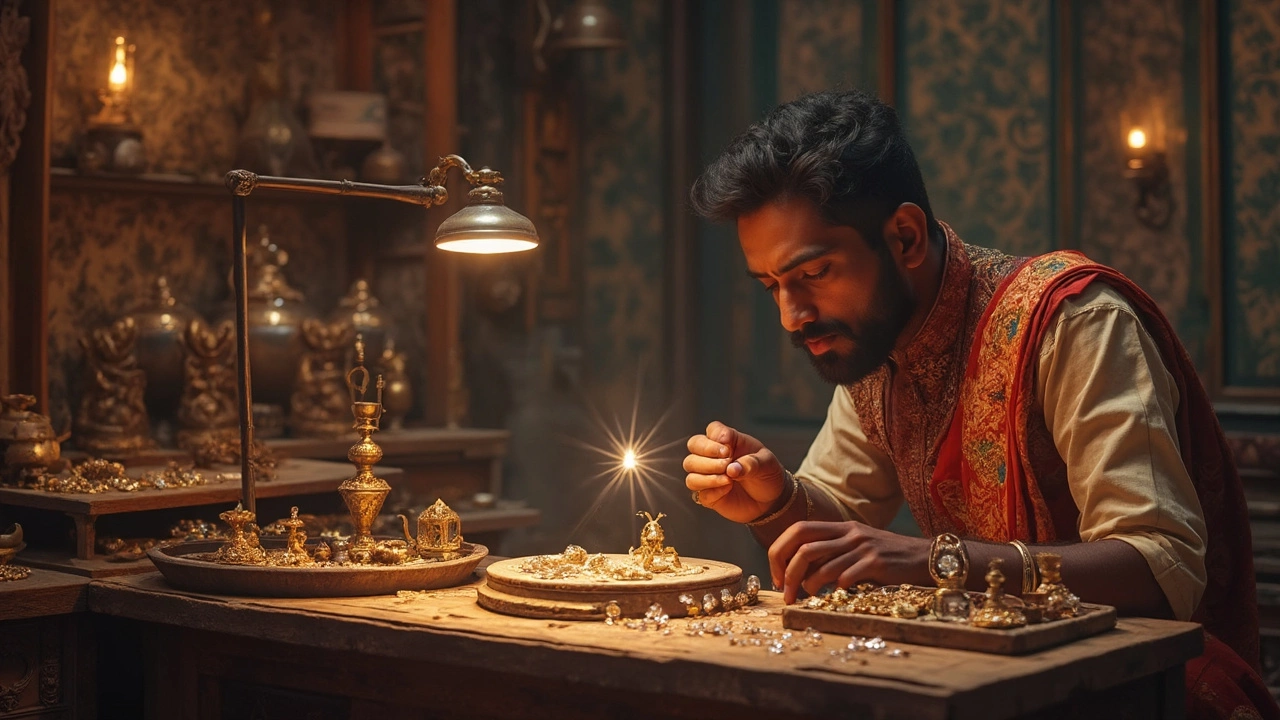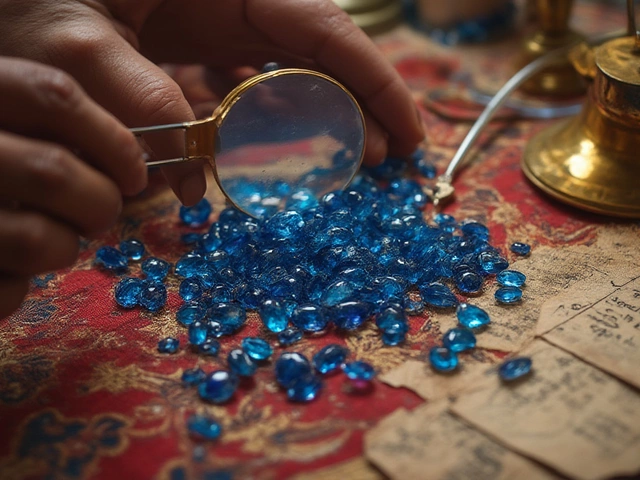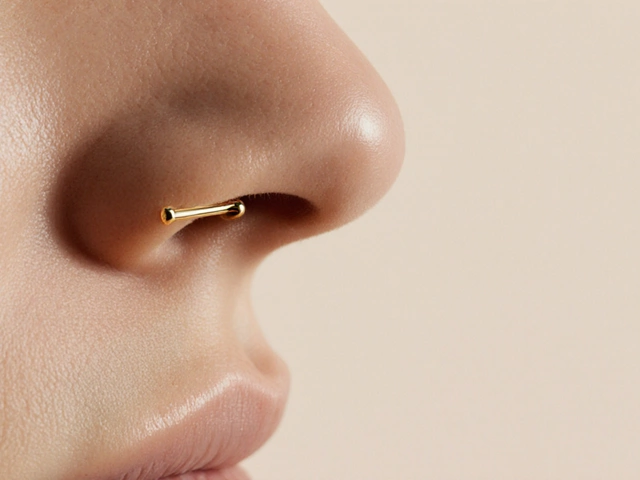When you're shopping for antique jewellery, nothing gets more attention than the diamond cut. It's not just about sparkle—it's about character, age, and the story behind each piece. In the world of antiques, some cuts catch countless eyes, but one has stayed at the top for decades: the old European cut.
This cut isn't just popular for nostalgia’s sake. Collectors and even new-age buyers swear by its chunky facets and warmer glow, something you don’t see in the sharper, more modern cuts. If you’re thinking of picking out a vintage ring or want that classic vibe, learning how to spot and appreciate this cut pays off. Plus, old European cut diamonds are often found in settings with incredible craftsmanship, a bonus for anyone who loves detail.
Picking a diamond is tough, especially when hunting for something with real history. Understanding why certain cuts matter—especially if you want a piece that stands out in a crowd—will save you heartbreak (and maybe even some cash). Let’s get into what makes this cut the number one choice for antique lovers and how you can spot the real deal without getting fooled.
- Why Diamond Cut Matters in Antique Jewellery
- The Cut That’s Always on Top
- History Behind the Craze
- How to Identify Authentic Antique Cuts
- Popular Antique Cuts vs. Modern Styles
- Tips for Buying Antique-Cut Diamonds
Why Diamond Cut Matters in Antique Jewellery
The diamond cut is not just a style choice—it’s the backbone of what makes antique jewellery stand out. In these pieces, the cut actually tells you when and possibly even where the diamond was crafted. Back in the day, technology was way different, so cutters relied mostly on handwork. Every little imperfection or odd facet adds to a diamond’s charm and tells part of its story.
While today’s diamonds aim for perfect symmetry and maximum sparkle, antique cuts like the old European cut and old mine cut have chunkier facets and softer outlines. This gives them a cozy glow, especially in low lighting—think candlelit dinners in 1900s Paris rather than blinding LED spotlights. That unique look is what makes many collectors and jewellery lovers prefer antique styles over modern ones.
- Antique diamond cuts usually show a tiny open point at the bottom (the culet)—modern stones often don’t have this.
- The facets are larger and not as sharp, making the sparkle softer and more romantic.
- Because they were cut by hand, no two antique diamonds are exactly alike. Each one feels personal and authentic.
If you’re after real antique jewellery, the cut instantly shows whether you have a true vintage piece or just a modern replica. For example, the old mine cut (from the 18th and 19th centuries) is almost cushion-shaped and looks plump, while the old European cut (hugely popular from the late 1800s to the 1930s) has a rounder shape but with deeper proportions than modern brilliant cuts.
| Diamond Cut | Era | Standout Feature |
|---|---|---|
| Old Mine Cut | 1700s-1870s | Cushion shape, visible culet |
| Old European Cut | 1890s-1930s | Round shape, chunky facets |
| Modern Round Brilliant | 1940s-now | Nearly perfect symmetry, maximum sparkle |
So, when you spot an old cut on a piece, you’re not just looking at a pretty stone—you’re holding onto a tiny snapshot of its time in history. That’s why the right diamond cut is everything for anyone who loves true antique jewellery.
The Cut That’s Always on Top
If you ask vintage jewellery dealers or collectors what the most sought after diamond cut is, you'll almost always hear the same answer: the old European cut. This diamond shape ruled the scene from the late 1800s through the 1930s and still creates buzz among buyers looking for real antique sparkle. Instead of the super-precise, laser-focused brilliance of modern diamond cuts, the old European cut offers a warm, bold, and recognizable shine.
These diamonds stand out because of their chunkier facets, higher crowns, and smaller tables. That translates to less harsh glare and more colorful flashes in candlelight—no wonder it was a favorite in the days when homes were lit by flickering flames. The proportions aren’t just about looks; they reflect the skill of diamond cutters who worked without the high-tech tools used today.
| Feature | Old European Cut | Modern Round Brilliant |
|---|---|---|
| Era | 1890–1930s | 1940s–present |
| Facets | 58 | 57 or 58 |
| Table Size | Small | Larger |
| Glow | Warm, broad flashes | Sharp, white sparkle |
As antique jewellery specialist Erica Weiner puts it:
“Old European cuts are a perfect reminder that diamonds were once cut by hand for maximum beauty—not for mass-produced perfection.”
If you’re after an authentic vintage vibe, this cut refuses to go out of fashion. Back then, each cutter put their own touch on every stone, so no two diamonds are ever truly the same. That gives old European cuts loads of personality. They're especially common in Edwardian, Victorian, and Art Deco jewellery. Check out movie stars or royals in old photos—you’ll spot these diamonds front and center.
And get this—old European cut diamonds are regularly at the heart of high-value auctions and prized family heirlooms. When you combine their rarity with their unmistakable look, it's easy to see why collectors and style hunters are hungry for them. If you want your piece of antique jewellery to turn heads and tell a story, this cut is your best bet.
History Behind the Craze
The hype around the most sought after diamond cut in the world of antique jewellery didn’t come out of nowhere. The old European cut, which everyone seems to be chasing, popped up in the late 1800s and kept growing until the 1930s. Back then, diamonds were cut by hand and eye, not with lasers and machines. That made each stone a bit imperfect—which weirdly is what collectors love today.
The old European cut was a game-changer when electric light started making its way into homes. These diamonds have bigger, chunkier facets, so they catch soft, warm light in a way modern cuts can’t compete with. As Art Deco and Victorian styles took off, this cut became the centerpiece for fancy rings, brooches, and necklaces. Famous French jeweler Henri Daussi was a legend in the 19th century, pushing the old European cut into the spotlight by perfecting its roundness and symmetry. These cuts were so good, even Hollywood started to notice during the early film era.
It’s not just about old-school charm, either. You’ll still spot this diamond shape in some of the biggest auction sales. Christie’s and Sotheby’s have sold pieces featuring old European cuts for double or triple what similar modern-cut stones fetch. Antique dealers love to point out that old European cut diamonds are usually recycled—meaning they’re actually the opposite of today’s mass-produced, mined stones. If you want an eco-conscious or unique ring, you can’t really get better than a one-of-a-kind vintage diamond.
Here’s a quick look at how the main diamond cuts evolved through the decades:
| Decade | Main Diamond Cut | What Stood Out |
|---|---|---|
| 1800s | Old Mine Cut | Cushion shape, chunky facets |
| Late 1800s-1930s | Old European Cut | Rounder shape, bigger facets, warm glow |
| 1940s onward | Modern Brilliant Cut | More sparkle, tighter symmetry |
If you ever get your hands on a family heirloom with an old European cut, hold onto it. Not only is it considered the most sought after diamond cut in terms of antique jewellery, but it’s also a part of jewellery history that’s getting rarer every year.

How to Identify Authentic Antique Cuts
Spotting a real vintage diamond, especially something like the old European cut, takes more than a quick glance. You need to know what markers set these stones apart, and it’s not just about their age. Most popular antique jewellery pieces have very different cuts compared to today’s styles. If you’ve had a chance to compare them side by side, you’ll see the difference right away.
First up, antique diamond cuts usually have chunkier facets. In particular, the old European cut stands out with:
- A small table (the flat top surface)
- A higher crown (sort of like the top “dome” is taller)
- Thicker girdles (the rim around the diamond often feels heavier)
- A larger, open culet (it’s like a tiny flat spot instead of a sharp point)
- Shorter lower half facets, which makes the light shimmer differently
Another big giveaway? The sparkle. Antique cuts like the old European cut don’t have that super-sharp, rainbow flash you get from modern brilliant cuts. Instead, the light is softer—more about a warm, romantic glow. Some gemologists call it a “candlelight” effect.
If you can, grab a jeweler’s loupe or even use your phone’s zoom. Check for wear and tear, tiny scratches, or tiny chips on the girdle. These signs can mean the stone was actually worn and loved for decades, not just recently set to look old. Also, vintage cuts might not look perfectly round—back in the day, cutting was done by hand, so a slight off-round shape is normal and adds more value for collectors.
Check out this quick table to help make sense of some key features:
| Feature | Authentic Antique Cut | Modern Brilliant Cut |
|---|---|---|
| Table Size | Small | Large |
| Crown Height | High | Low |
| Culet | Large/Open | Barely there/None |
| Facet Pattern | Chunky, uneven | Precise, tight |
| Sparkle | Warm, candlelight | Bright, rainbow flashes |
Got paperwork with your diamond? Double check dates! Stones certified by GIA or AGS as “old European” or “old mine” cuts usually give the game away. Remember, antique pieces might have a platinum or yellow gold setting with hand-finished details. If it looks too perfect or downright “machine made,” question it.
Honestly, the best way to learn what makes a genuine most sought after diamond cut tick is to check out pieces in person. Try visiting local antique jewellery stores or ask to see diamonds loose, outside the setting. You’ll soon notice real antiques just feel different in your hand—there’s history packed in every facet.
Popular Antique Cuts vs. Modern Styles
If you’ve ever compared old rings with new ones, you’ll notice antique diamonds look really different from what’s at today’s jewellery stores. The most popular antique cuts—like the old European, old mine, and rose cuts—are all about chunky facets, deep profiles, and a softer, ‘glow’ kind of sparkle rather than a razor-sharp shine. These cuts were all hand-shaped by skilled cutters, giving each diamond a slightly unique vibe and a distinctly vintage feel.
Modern diamond cuts, like the round brilliant, are designed for max sparkle. Jewelers use machines for precise angles, which means every stone looks nearly identical and puts out crazy fire and brilliance in any light. The round brilliant cut has 57 or 58 facets and is basically a math equation turned into a gem for maximum bling. But here’s the wild part—old European cuts, the king of the antique jewellery scene, usually have around 58 facets too, just arranged differently for a chunkier, softer look.
If you lined up the most common cuts side by side, here’s how some key features stack up:
| Diamond Cut | Facet Style | Sparkle Type | Era |
|---|---|---|---|
| Old European | Large facets, high crown | Warm, ‘glowy’ brilliance | Late 1800s - early 1900s |
| Old Mine | Cushion shaped, chunky facets | Subtle, moody fire | 1700s to late 1800s |
| Rose Cut | Flat bottom, domed with facets | Soft, subtle sparkle | 1500s onward |
| Round Brilliant (Modern) | Precise small facets | Intense, sharp brilliance | 1919 to now |
The biggest difference comes down to personality. Antique cuts go with warm golds, chunky settings, and have quirks that collectors love. If you're after that traditional engagement-ring look you see at chain stores, you’re usually looking at a modern round brilliant. Want that subtle, handcrafted magic? Stick with vintage engagement rings and their classic, old-school cuts. Whichever way you go, pick the one that speaks to your style—just know what you’re getting and why.
Tips for Buying Antique-Cut Diamonds
Purchasing a true antique jewellery piece with an authentic most sought after diamond cut is a bit different from shopping for a modern ring. You need to watch out for details that tell you it’s not a recent reproduction or a mass-market stone swapped into a vintage setting. Here’s what to check before you pull out your wallet or commit to a bid at auction.
- Understand Key Features: The old European cut is famous for its round shape, open culet (a visible tiny circle at the bottom), high crown, and larger facets. It's less sparkly than modern brilliants but gives a soft, almost candle-lit shine people love in vintage engagement rings.
- Look for Wear and Tear: Real antique diamonds usually have tiny nicks or a slightly worn girdle (the stone’s outer edge). Polishing marks and a creamy glow—rather than icy brilliance—are good signs.
- Check for Certification: Most reputable sellers will give you a report from GIA or AGS confirming the age and origin. For older stones, independent antique experts can help verify authenticity.
- Ask About the Setting: A diamond’s original setting is hugely valuable if you want a completely authentic antique piece. Prong styles, engraving details, and metal types (like platinum or early gold alloys) can all reveal if the piece is genuinely from a certain era.
- Compare Prices: Old cut stones often cost less per carat than modern ones, but rare sizes or outstanding craftsmanship can drive the numbers up. Here’s how prices are stacking up for different cuts in the vintage market:
| Diamond Cut | Estimated Price Range per Carat (USD) |
|---|---|
| Old European Cut | $2,500 - $8,000 |
| Old Mine Cut | $2,000 - $6,000 |
| Modern Round Brilliant | $3,500 - $12,000 |
- Buy from Trusted Sources: Always buy from sellers who specialize in antique jewellery and have a track record. Check for return policies and after-sale support, especially when shopping online.
Extra tip: If you see a diamond that looks too perfect and super bright, double-check—modern recuts can sneak into old mounts. Genuine antique jewellery pieces tend to look a little different from today’s machine-cut perfection. Trust your eye, ask questions, and don’t hesitate to walk away if something doesn’t add up.



